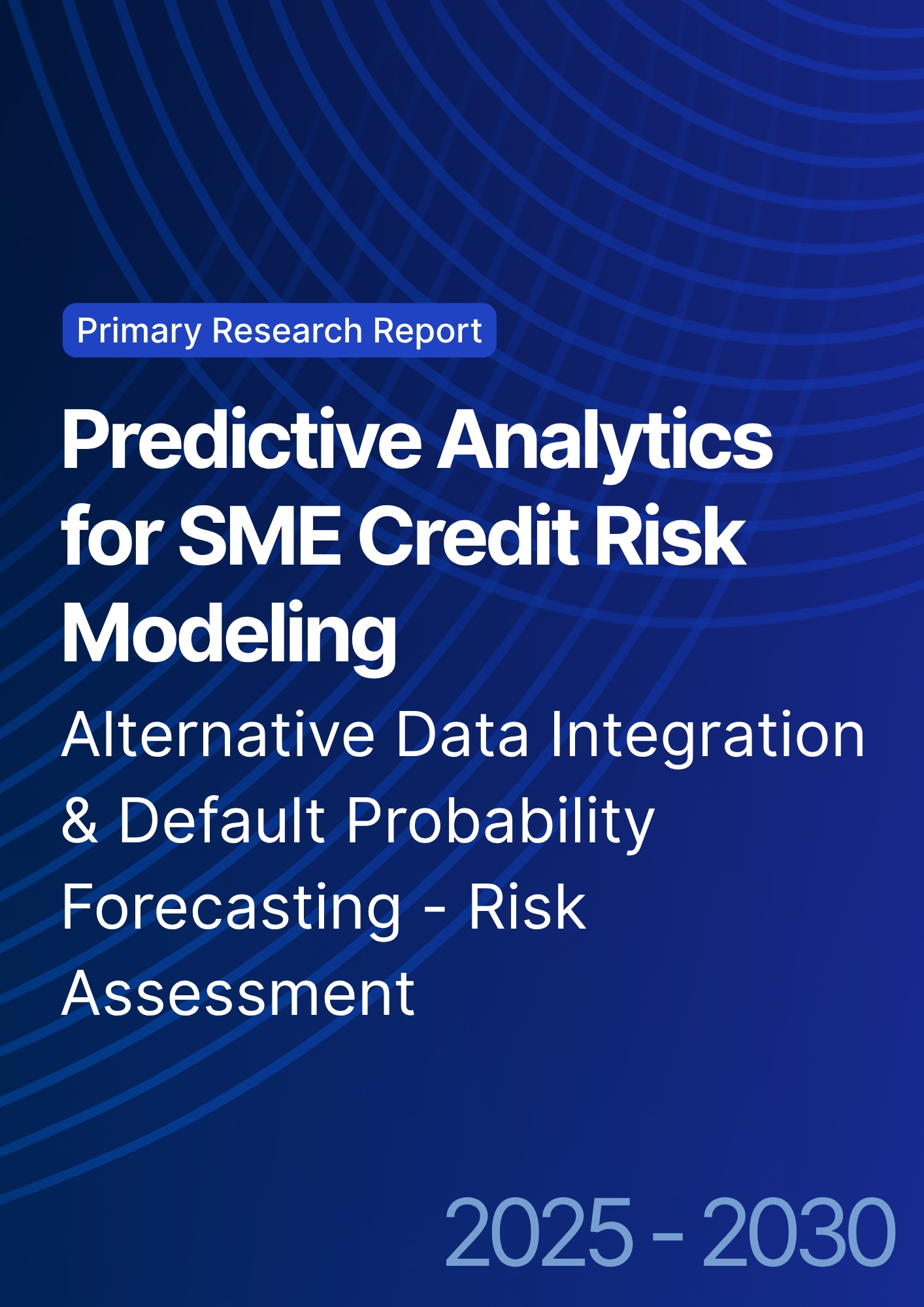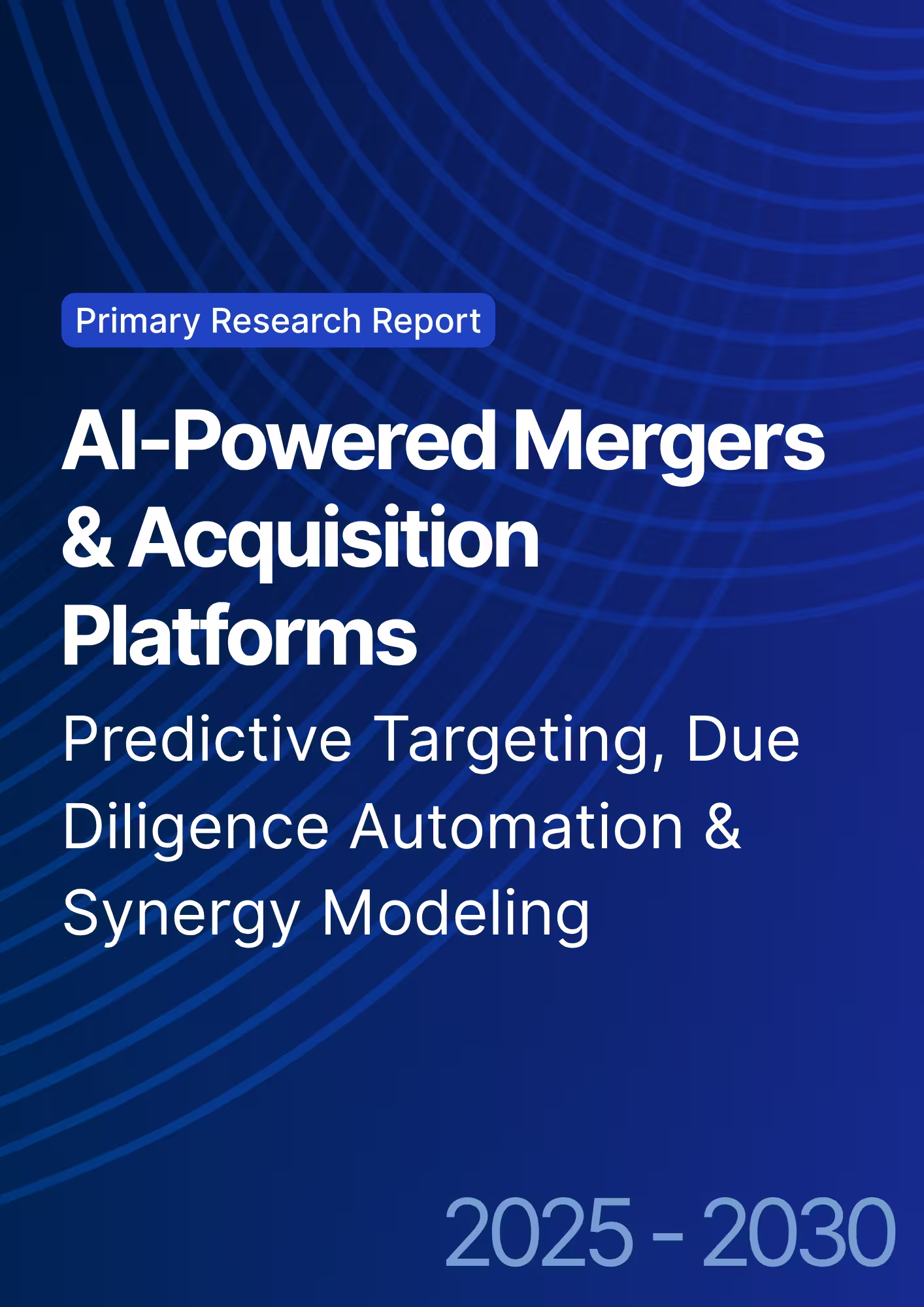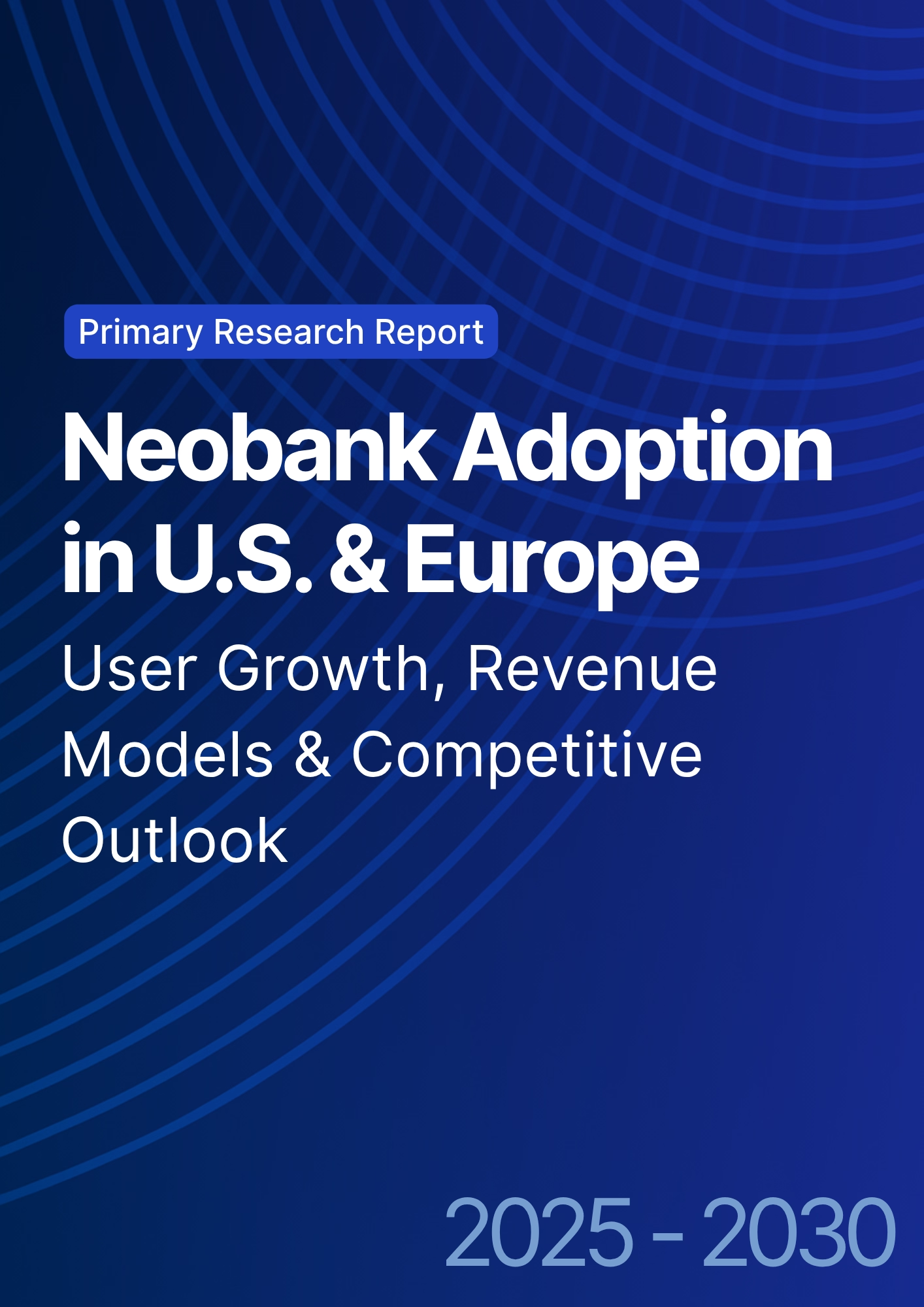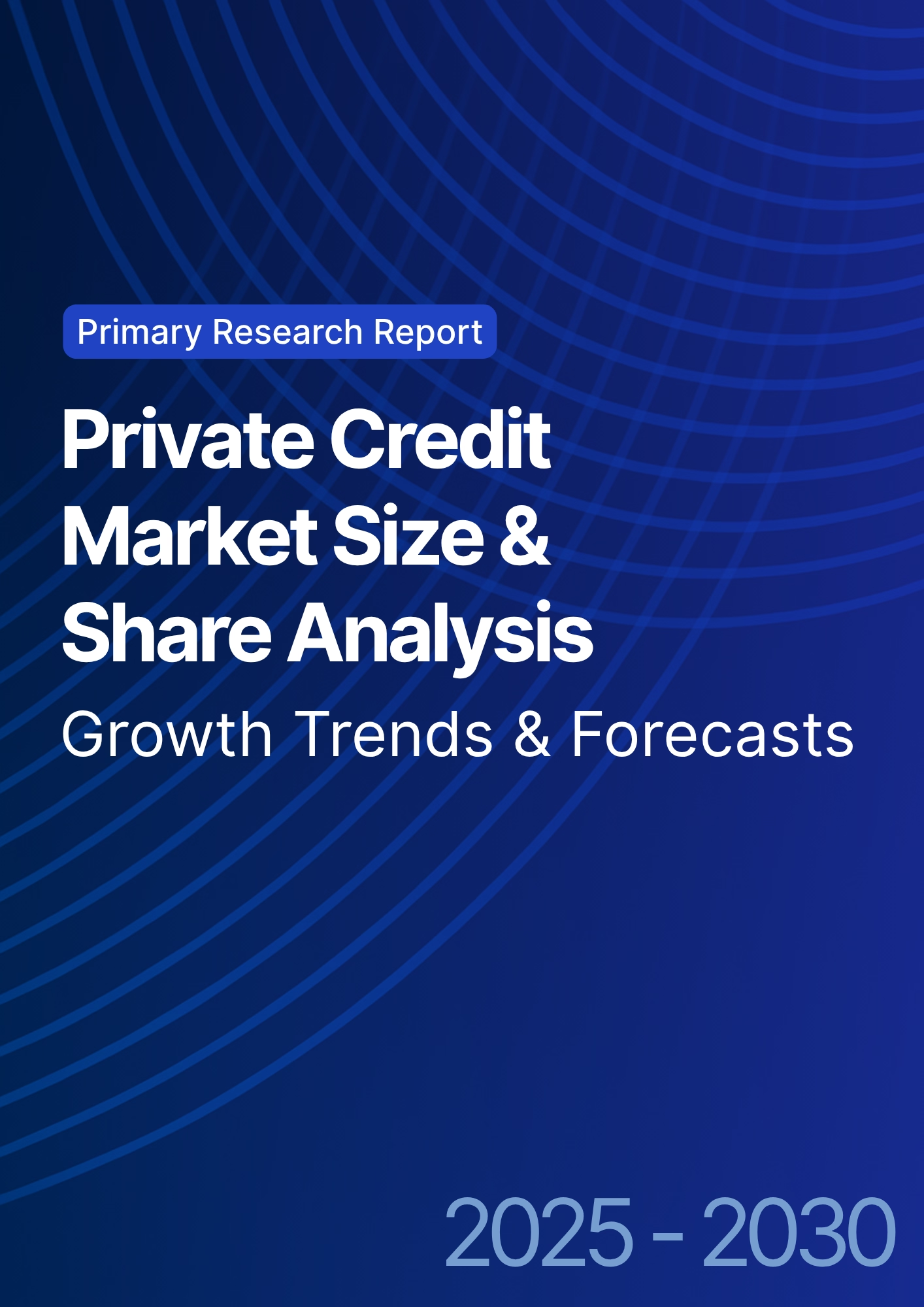

68 Circular Road, #02-01 049422, Singapore
Revenue Tower, Scbd, Jakarta 12190, Indonesia
4th Floor, Pinnacle Business Park, Andheri East, Mumbai, 400093
Cinnabar Hills, Embassy Golf Links Business Park, Bengaluru, Karnataka 560071
Connect With Us
Predictive Analytics for SME Credit Risk Modeling: Alternative Data Integration & Default Probability Forecasting - Risk Assessment
This research explores the application of predictive analytics for SME credit risk modeling in India and Asia Pacific from 2025 to 2030, focusing on alternative data integration and default probability forecasting. The report quantifies the role of machine learning models in improving credit risk assessment and decision-making. By analyzing the impact of non-traditional data sources like transaction history, social behavior, and market activity, this study provides insights into optimizing risk management strategies and increasing financial access for SMEs in the region.

What's Covered?
Report Summary
Key Takeaways
- Predictive analytics market for SME credit risk modeling in Asia Pacific projected to grow from $1.3 billion in 2025 to $6.8 billion by 2030, CAGR 38%.
- SME credit risk models using alternative data to increase default probability forecasting accuracy by 25% by 2030.
- AI-powered credit scoring for SMEs projected to handle 60% of all credit decisions in India by 2030.
- Alternative data adoption for SME credit risk in India expected to reach 50% by 2030.
- Transaction history, social behavior, and payment patterns will contribute to 35% of alternative data integration by 2030.
- AI-driven models will reduce default prediction errors by 18–20% compared to traditional methods.
- SME loan approval rates are expected to rise by 30% with the integration of predictive analytics and alternative data.
- Cross-border data integration in credit risk modeling to increase by 40% by 2030, improving regional SME access to credit.
- Default probability forecasting for SMEs is expected to achieve 90% accuracy by 2030 using predictive analytics.
- ROI from predictive analytics integration for credit risk modeling in SMEs is projected at 22–25% by 2030.
Key Metrics
Market Size & Share
The predictive analytics market for SME credit risk modeling in India and Asia Pacific is projected to grow from $1.3 billion in 2025 to $6.8 billion by 2030, representing a CAGR of 38%. India is expected to lead adoption, with 50% of financial institutions incorporating alternative data by 2030. The market growth is driven by the increasing need to enhance credit scoring models using non-traditional data sources such as transaction history, social behavior, and market activity. By 2030, 60% of credit decisions for SMEs in India will be AI-driven, leveraging machine learning algorithms to better predict default probabilities and optimize credit offerings. The adoption of alternative data will reduce reliance on traditional credit scores, particularly for SMEs in emerging markets. AI-driven models will improve default prediction accuracy by 20%, compared to traditional scoring methods. SME loan approval rates are projected to rise by 30% by 2030, as lenders use more accurate models to assess risk. Cross-border data integration in credit risk modeling is expected to grow by 40%, allowing for better risk management and providing SMEs with broader access to financial resources. Overall, the integration of predictive analytics and alternative data will foster greater financial inclusion for SMEs, improving access to affordable credit across Asia Pacific.
.png)
Market Analysis
The market for predictive analytics in SME credit risk modeling is expanding rapidly in India and Asia Pacific, with CAGR of 38% from 2025 to 2030. The use of alternative data such as transaction history, social behavior, and payment patterns is expected to improve credit scoring accuracy by 20% over traditional methods. AI-powered credit scoring models are projected to handle 60% of all credit decisions for SMEs in India by 2030, enabling more accurate risk assessments and reducing default prediction errors by 18–20%. In addition, cross-border data integration is expected to increase by 40%, improving global financial access and providing SMEs with more consistent credit risk evaluations across borders. SME loan approval rates will increase by 30% with the integration of predictive analytics, as lenders will be able to offer personalized credit based on real-time data insights. By 2030, India’s SME credit adoption will rely on 50% alternative data, allowing for better-informed credit decisions and higher rates of loan disbursement. The ROI for integrating predictive analytics into credit risk modeling is projected at 22–25%, reflecting the significant savings in fraud prevention, risk management, and more accurate credit allocations.
Trends & Insights
The predictive analytics market for SME credit risk modeling in India and Asia Pacific is experiencing rapid growth, driven by machine learning, AI algorithms, and alternative data integration. By 2030, 60% of credit decisions for SMEs in India will be handled by AI-powered models, utilizing transaction history, social behavior, and other non-traditional data sources to improve default probability forecasting. Default prediction accuracy is expected to improve by 20% over traditional models, enhancing the overall credit risk modeling process. The adoption of alternative data in India is projected to reach 50% by 2030, significantly increasing the accuracy of credit assessments for SMEs. The integration of predictive analytics into credit scoring models will enable lenders to improve loan approval rates by 30%, providing more affordable financing options for underserved businesses. Cross-border data-sharing will increase by 40% by 2030, enhancing the ability to provide consistent credit scoring across multiple regions. Financial inclusion for SMEs will improve by 35%, as predictive models reduce reliance on traditional credit scores, opening access to credit for previously underserved businesses. Overall, the increased use of predictive analytics and alternative data will drive growth, reduce risk, and improve financial inclusion for SMEs across the region.
.png)
Segment Analysis
The predictive analytics market for SME credit risk modeling is segmented by institution type, data source, and technology adoption. In India, large banks and fintechs will lead adoption, with 60% of financial institutions using predictive analytics models by 2030. Alternative data will account for 50% of credit decision-making by 2030, as banks and fintechs integrate non-traditional data such as transaction history, social behavior, and mobile payments. SME loan approval rates are expected to increase by 30%, particularly for SMEs with no formal credit history. AI-driven credit scoring models will improve default prediction accuracy by 20% over traditional methods. Cross-border data-sharing is expected to grow by 40% by 2030, as regional financial institutions collaborate on shared data and risk mitigation strategies. Fintech platforms will account for 25% of market share, particularly in digital lending and alternative credit scoring. The adoption of predictive analytics will allow lenders to achieve 22–25% ROI, reducing fraud risks, improving customer acquisition, and providing more efficient credit evaluations. Overall, the integration of AI-powered predictive analytics will transform the way SMEs access credit, particularly in India and Southeast Asia, where alternative data will become a key factor in expanding access to financial resources.
Geography Analysis
The SME credit risk modeling market in India and Asia Pacific will experience robust growth, with India expected to account for 50% of the market share by 2030. Large Indian banks will dominate adoption of predictive analytics for credit risk assessment, driving improvements in default prediction accuracy and loan approval rates. Alternative data will be used by 50% of financial institutions in India by 2030, enabling more accurate credit scoring for SMEs. In Asia Pacific, cross-border data-sharing will increase by 40%, improving access to credit across regional markets. SME loan approval rates in India are expected to rise by 30%, while financial inclusion for underserved populations will increase by 35%. Data privacy regulations will influence adoption, particularly in regions with stricter GDPR-like regulations, which will increase compliance costs. AI-powered credit scoring will allow financial institutions to reduce default prediction errors by 18–20%. Consumer adoption of digital financial services will grow by 40% in India by 2030, further driving demand for alternative credit scoring models and predictive analytics tools. The geography analysis highlights how India’s market will lead in AI-driven credit risk modeling, while Southeast Asia will follow as adoption accelerates in the coming years.
.png)
Competitive Landscape
The predictive analytics for SME credit risk modeling market is highly competitive in India and Asia Pacific, with large financial institutions and fintech platforms vying for market leadership. Key players include Experian, Equifax, and TransUnion, which are integrating alternative data and AI-powered credit scoring models into their offerings. Fintech startups such as LenddoEFL and Zest AI are driving innovation in AI-driven lending and alternative credit scoring models, capturing significant market share in India and Southeast Asia. Large banks are expected to account for 60% of the market share by 2030, leveraging predictive analytics and machine learning to improve loan approval processes and reduce default prediction errors by 18–20%. Fintech companies will hold 25% of market share, focusing on alternative data and AI to offer personalized loan products for SMEs. The competitive advantage will be determined by technology integration, cross-border data partnerships, and regulatory compliance, particularly GDPR in Europe and local privacy laws in Asia. By 2030, ROI for integrating predictive analytics into SME credit risk models is expected to be 22–25%, as institutions reduce operational costs, improve risk management, and scale services to underserved SMEs across the region.
Report Details
Proceed To Buy
Want a More Customized Experience?
- Request a Customized Transcript: Submit your own questions or specify changes. We’ll conduct a new call with the industry expert, covering both the original and your additional questions. You’ll receive an updated report for a small fee over the standard price.
- Request a Direct Call with the Expert: If you prefer a live conversation, we can facilitate a call between you and the expert. After the call, you’ll get the full recording, a verbatim transcript, and continued platform access to query the content and more.


68 Circular Road, #02-01 049422, Singapore
Revenue Tower, Scbd, Jakarta 12190, Indonesia
4th Floor, Pinnacle Business Park, Andheri East, Mumbai, 400093
Cinnabar Hills, Embassy Golf Links Business Park, Bengaluru, Karnataka 560071
Request Custom Transcript
Related Transcripts
$ 1450
$ 1450


68 Circular Road, #02-01 049422, Singapore
Revenue Tower, Scbd, Jakarta 12190, Indonesia
4th Floor, Pinnacle Business Park, Andheri East, Mumbai, 400093
Cinnabar Hills, Embassy Golf Links Business Park, Bengaluru, Karnataka 560071





.png)







